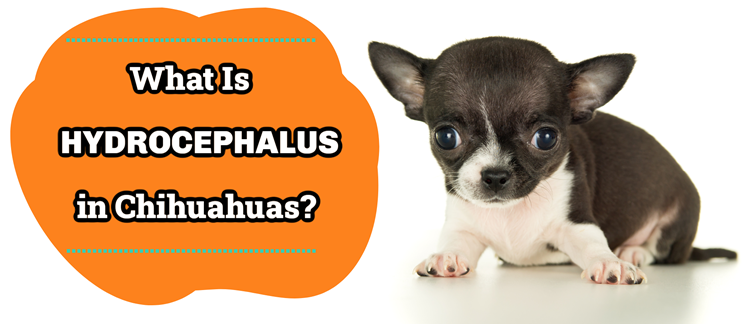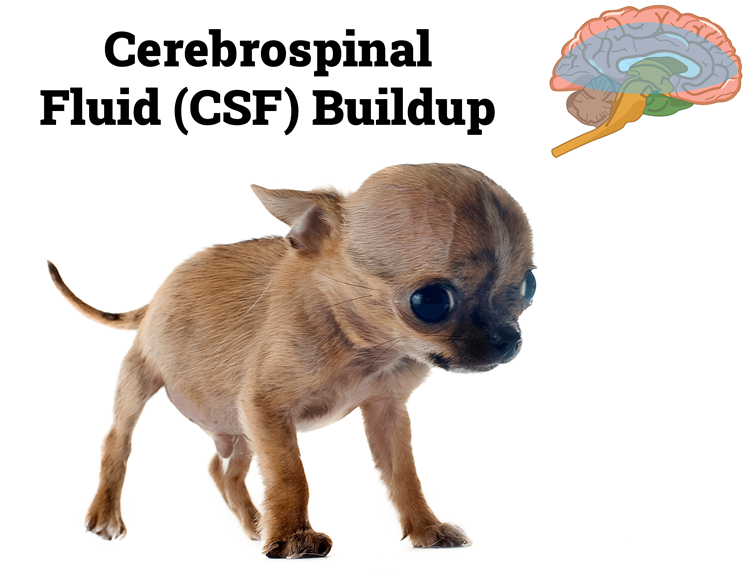
Chihuahuas may have one of the longest lifespans of all dog breeds, but they can still suffer from various health problems, including hydrocephalus. Known colloquially as “water on the brain,” it’s a serious medical condition involving the central nervous system. Many Chihuahuas are born with hydrocephalus, whereas others develop it later in life. Here’s everything you need to know about hydrocephalus in Chihuahuas.
- What Is Hydrocephalus?
- Congenital vs Acquired Hydrocephalus: What’s the Difference?
- Causes of Hydrocephalus
- Signs and Symptoms of Hydrocephalus
- Diagnosis for Hydrocephalus
- Treatment Options for Hydrocephalus
- Tips for Managing Your Chihuahua’s Hydrocephalus
- How Long Do Chihuahuas With Hydrocephalus Live?
- In Conclusion
What Is Hydrocephalus?
Hydrocephalus is a serious medical condition that’s characterized by the buildup of cerebrospinal fluid (CSF) buildup within the ventricles brain. If left untreated, it can lead to brain damage or death.
The term “hydrocephalus” comes from the Greek words “hydro” and “cephalus,” meaning water and head, respectively. Rather than draining, CSF accumulates within the cavities of the Chihuahua’s brain, resulting in a fluid-filled head.
CSF is a clear fluid that’s produced by an inner part of the brain known as the choroid plexus. Consisting of a complex network of blood vessels and cells, the choroid plexus plays an important role in protecting the brain and spinal cord from injury. It produces CSF that surrounds and cushions the brain and spinal cord.
Normally, CSF gradually drains and is reabsorbed by the body. Hydrocephalus, however, involves the accumulation of CSF. Chihuahuas may produce too much CSF, or their bodies may not drain CSF properly. Regardless, those suffering from hydrocephalus will have an excess of CSF within their brains. All of this CSF will create pressure inside the skull that presses against the brain.

Congenital vs Acquired Hydrocephalus: What’s the Difference?
Hydrocephalus can be congenital or acquired. Most cases are congenital, meaning Chihuahuas are born with it.
Acquired hydrocephalus, on the other hand, means that Chihuahuas develop it later in life. Chihuahua puppies may have normal CSF levels within their brains at birth, only to develop hydrocephalus in adulthood or seniorhood.
Causes of Hydrocephalus
Most causes of congenital hydrocephalus are attributed to genetics. Toy breeds are genetically predisposed to hydrocephalus. When compared to larger breeds, they are more likely to be born with anatomical features or malformations that allow CSF to build up within their brains. A dome-shaped head, for instance, may increase the risk of hydrocephalus.
Other breeds that are genetically predisposed to hydrocephalus include:
- Beagle
- Bichon Frise
- Boston Terrier
- Bull Terrier
- Bullmastiff
- Cairn Terrier
- Cavalier King Charles Spaniel
- Dachshund
- English Bulldog
- English Toy Spaniel
- French Bulldog
- Lhasa Apso
- Maltese
- Pomeranian
- Pug
- Shih Tzu
- Toy Poodle
- West Highland White Terrier
- Yorkshire Terrier
Dystocia can cause congenital hydrocephalus in the fawn’s offspring. Dystocia is the catch-all term used to describe birthing difficulties. It involves the fawn struggling to pass the fetus through her pelvic canal. Chihuahua puppies may experience head trauma during birth, such as brain hemorrhaging, that manifests in the form of hydrocephalus.
Brain tumors can cause acquired hydrocephalus. Primary brain tumors are abnormal cellular growths that originate in the brain. Secondary brain tumors are abnormal cellular growths that originate elsewhere but have spread to the brain. Both types of brain tumors consist of tissue masses that can increase pressure inside the skull and disrupt CSF drainage.
In addition to brain tumors, infections can cause acquired hydrocephalus. Viral, bacterial, fungal and even parasitic infections can cause inflammation of the brain. As the Chihuahua’s brain begins to swell from the infection, CSF may build up.
Signs and Symptoms of Hydrocephalus
Recognizing the signs and symptoms of hydrocephalus is crucial for early intervention. While they may vary depending on the severity of the condition — and whether it’s congenital or acquired — you may notice the following signs and symptoms if your Chihuahua is suffering from hydrocephalus.
Common signs and symptoms of hydrocephalus include:
- Wide or bulging eyes
- Enlarged heard
- Lethargy
- “Head pressing” (pressing the head against a wall)
- Loss of coordination
- Stiff gait
- Potty-training difficulty
- Seizures
- Stunted growth
- Restlessness (e.g. walking in circles)
- Blindness
- Behavioral changes
It’s important to note that Chihuahuas suffering from congenital hydrocephalus may not exhibit any signs or symptoms — at least initially. They may look and act normal at birth. At about 12 weeks of age, though, some of the aforementioned signs and symptoms may appear.
Diagnosis for Hydrocephalus
Veterinarians typically diagnose hydrocephalus via imaging. They may begin with a physical examination to look for telltale symptoms of this condition, such as bulging eyes or loss of coordination. Veterinarians may then use an imaging technology to look inside of the Chihuahua’s skull and determine whether there’s a buildup of CSF present.
If the Chihuahua has a molera, the veterinarian may perform an ultrasound. A molera is an opening in a Chihuahua’s skull. Most Chihuahuas are born with an incomplete skull because it allows them to pass through the pelvic canal more easily. Ultrasound imaging allows veterinarians to look through the Chihuahua’s molera, thus revealing the Chihuahua’s brain.
Computerized tomography (CT) and magnetic resonance imaging (MRI) scans are commonly used to diagnose hydrocephalus. The former imaging technology involves the use of X-rays and a computer program to create a three-dimensional view of the inside of a Chihuahua’s skull. The latter imaging technology involves the use of a powerful magnetic device, known as an MRI machine or scanner, to create images of the inside of a Chihuahua’s skull.
If the Chihuahua is suffering from hydrocephalus, a CT or MRI scan may show enlarged brain ventricles due to the fluid buildup. CT and MRI scans also allow veterinarians to look for tumors, which can cause hydrocephalus.
Treatment Options for Hydrocephalus

The treatment approach for hydrocephalus will depend on several factors, including the severity of the condition, the underlying cause, the age of the Chihuahua and the Chihuahua’s overall health. While there is no cure for hydrocephalus, treatment options aim to alleviate symptoms and manage the condition effectively. Common treatment methods include:
Veterinarians may prescribe medications to treat hydrocephalus. Diuretics, for instance, have been shown to alleviate CSF buildup within the brain. They work by encouraging the kidneys to move water and salt from the Chihuahua’s body more quickly. The downside to treating hydrocephalus with diuretics is that it places Chihuahuas at risk for dehydration.
Anti-inflammatory medication is commonly used to treat hydrocephalus. Most cases of hydrocephalus involve inflammation of the brain. Corticosteroids like Prednisone can reduce this swelling while easing the symptoms of hydrocephalus.
Chihuahuas suffering from hydrocephalus may experience seizures, in which case veterinarians may recommend anti-seizure medication. Chihuahuas may also have infections that cause hydrocephalus. Veterinarians can treat infections by prescribing antibiotics, antivirals, antifungals or antiparasitics.
The proton pump inhibitor (PPI) omeprazole has become an increasingly popular form of treatment for hydrocephalus. It’s used primarily to treat heartburn in humans, as it reduces the amount of acid produced by the stomach. But omeprazole has since made its way into the field of veterinary care, with many veterinarians using it to treat hydrocephalus. One study found that omeprazole reduced CSF production by 26% in dogs.
Surgical Treatment
For severe cases of hydrocephalus, veterinarians may recommend surgery. Ventriculoperitoneal shunting can reduce CSF buildup. This surgical procedure involves the placement of a catheter-like device known as a shunt within the Chihuahua’s brain and body. The shunt will absorb excess CSF, redirecting it away from the Chihuahua’s brain where it can be safely absorbed by the Chihuahua’s body.
While effective at reducing CSF buildup within the brain, there’s a risk of infection when treating hydrocephalus with ventriculoperitoneal shunting. The shunt may harbor infection-causing bacteria, such as Staphylococcus epidermidis, that enter the Chihuahua’s body during the procedure.
The shunt itself may also need to be replaced. As the Chihuahua ages, he may outgrow the original shunt. A board-certified veterinary surgeon will then have to take out the original shunt and replace it with a new, larger shunt.
Tips for Managing Your Chihuahua’s Hydrocephalus

If your Chihuahua has been diagnosed with hydrocephalus, you might be wondering how to manage it. The most important thing you can do is follow the veterinarian’s instructions. The veterinarian may prescribe medication while also recommending lifestyle changes. In severe cases, the veterinarian may recommend medication and surgery.
Hydrocephalus can occur in both dogs and cats, so most veterinarians are familiar with it. Along with the veterinarian’s recommendations, here are some additional ways to manage your Chihuahua’s hydrocephalus.
- Use caution when picking up and playing with your Chihuahua to protect his head from injury.
- If your Chihuahua struggles to walk on his own, consider investing in a doggy wheelchair.
- Create a safe living environment for your home by removing potential hazards, such as furniture or hard objects he may walk into and bump his head.
- Don’t overstimulate your Chihuahua. Loud noises, bright lights and other forms of stimuli may cause anxiety.
- Increase your Chihuahua’s intake of omega-3s. Not to be confused with omega-6s, these fatty acids will reduce inflammation in your Chihuahua’s body. Veterinarians can recommend other dietary changes to improve your Chihuahua’s quality of life.
- Make your home more accessible by placing doggy ramps near couches, beds and other elevated surfaces that your Chihuahua frequently accesses.
- Provide your Chihuahua with a comfortable and quiet space to rest.
- Supervise your Chihuahua when he’s around children or other pets.
- Take your Chihuahua to the veterinarian for a checkup at least once a year.
How Long Do Chihuahuas With Hydrocephalus Live?
The lifespan of a Chihuahua with hydrocephalus will vary depending on many factors. Chihuahuas with acquired hydrocephalus typically have a shorter lifespan than those with congenital hydrocephalus. The most common cause of acquired hydrocephalus is a brain tumor, which is difficult to treat.
Some cases of hydrocephalus are more severe than others. Chihuahuas with minor hydrocephalus have less CSF buildup and brain swelling than those with severe hydrocephalus. Therefore, they typically live longer than Chihuahus with severe hydrocephalus.
Early detection is essential to a positive prognosis. The sooner hydrocephalus is detected in a Chihuahua, the better. Early detection allows veterinarians and owners to begin a treatment regimen that increases the Chihuahua’s life expectancy.
In Conclusion
Hydrocephalus is a serious medical condition that involves the buildup of spinal fluid known as CSF within the brain. It’s common in Chihuahuas and other toy breeds. The choroid plexus is the part of the brain that produces CSF. Normally, the Chihuahua’s body will gradually absorb CSF, but Chihuahuas suffering from hydrocephalus will either produce too much CSF, or their bodies won’t absorb it properly.
References:
https://veterinarypartner.vin.com/default.aspx?pid=19239&id=4952484
https://www.ufaw.org.uk/dogs/chihuahua-hydrocephalus
Does your Chihuahua have hydrocephalus? Let us know in the comments section below!